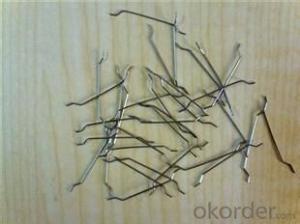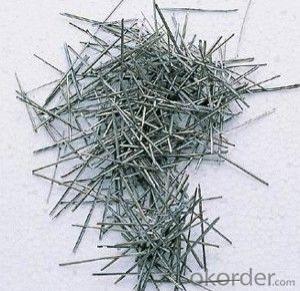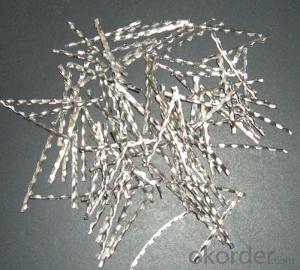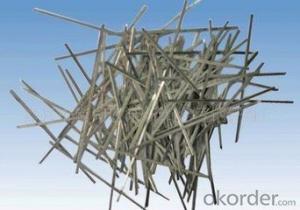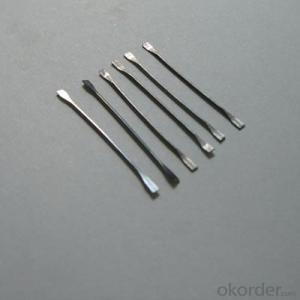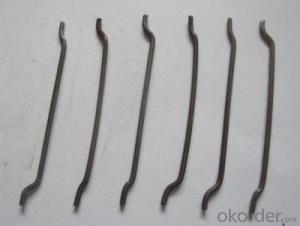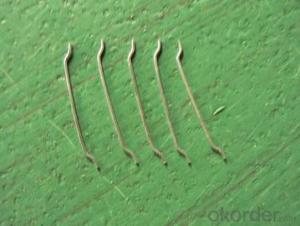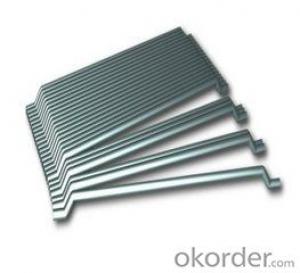Concrete steel fiber 0.9/50 from CNBM China
- Loading Port:
- Tianjin
- Payment Terms:
- TT OR LC
- Min Order Qty:
- 1 m.t.
- Supply Capability:
- 5000 m.t./month
OKorder Service Pledge
Quality Product, Order Online Tracking, Timely Delivery
OKorder Financial Service
Credit Rating, Credit Services, Credit Purchasing
You Might Also Like
Quick Details
Place of Origin: Tianjin, China (Mainland)
Model Number: 0.9
Material: Steel
Production Process: Cold drawn
Lengh: 50
Type: 1
Compressive Strength: >1200MPa
Aspect ratio: 56
Standard: ASTM A820M-11
Section Shape: Circular
Application: Concrete Reinforcement
Packaging & Delivery
| Packaging Details: | 20 kg/Bag,50 bags/Pallet or 1,000kg/ Bulk Bag |
|---|---|
| Delivery Detail: | 1 Month |
Product Description
| Diameter | 0.90 | mm | 0.04 | in |
| Length | 50.00 | mm | 1.96 | in |
| Aspect Ratio | 56 | |||
| Tensile strength | 1200 MPa | |||
| Type | Cold drawn Steel Fiber | |||
| End | Hooked-end Steel Fiber | |||
| Glued/Loose | Glued Steel Fiber | |||
| Bending Angle | 45°(min.30°) | |||
| Usage & Performance | Floor:Trafficked areas and Industrial floors | |||
| Shotcrete :Slope stabilization and Final lining | ||||
| Precast concrete:Pipe and Railway sleepers | ||||
| Packing | Standard Export Pallet Packing | Bag Packing | 20 kg/Bag,50 bags/Pallet | |
| Bulk Packing | 1,000kg/ Bulk Bag | |||
| Loading Quantity | 20’GP | 20-25 Tonne/Tonnes | ||
| 40’GP | 25-27 Tonne/Tonnes | |||
| 40’HQ | 25-27 Tonne/Tonnes | |||
| MOQ | 1 kg for trial order | |||
| Supply Ability | 10,000 Tonne/Tonnes per Year | |||
| Payment Terms | T/T or L/C at sight | |||
| Delivery Time | Within 15 days after receiving deposit or original L/C at sight | |||
| Certification | ISO9001:2000, CE, | |||
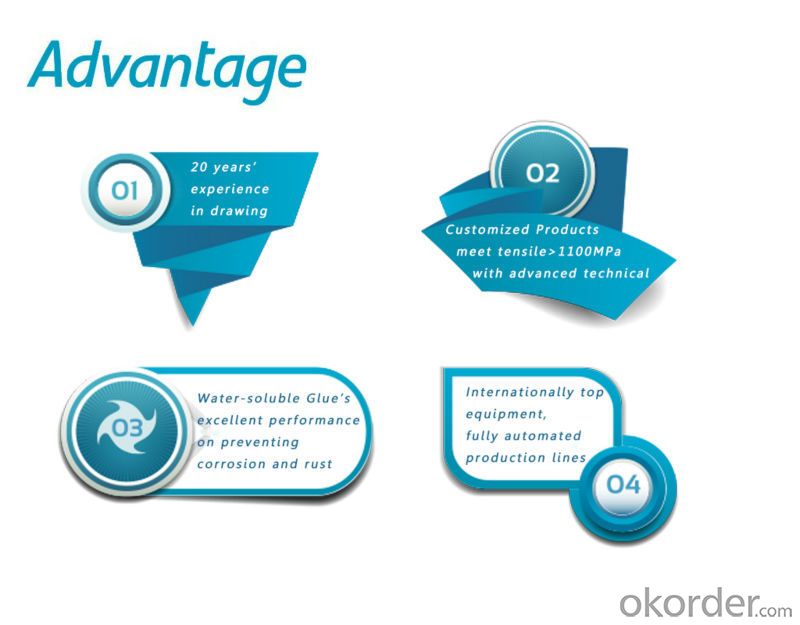
| Product | Diameter | Length mm/in | Aspect Ratio | Type | Packing |
| G-6030 | 0.5 mm (0.0197 in) | 30 mm (1.1811 in) | 60 | Glued | 20 kg/Bag, or 1,000kg/ Bulk Bag |
| G-6535 | 0.55 mm (0.0217 in) | 35 mm (1.3780 in) | 65 | Glued | 20 kg/Bag, or 1,000kg/ Bulk Bag |
| G-6035 | 0.6 mm (0.0236 in) | 35 mm (1.3780 in) | 60 | Glued | 20 kg/Bag, or 1,000kg/ Bulk Bag |
| G-8060 | 0.75 mm (0.0295 in) | 60 mm (2.3622 in) | 80 | Glued | 20 kg/Bag, 50 bags/Pallet |
| G-6060 | 0.9 mm (0.0354 in) | 60 mm (2.3622 in) | 60 | Glued | 20 kg/Bag, 50 bags/Pallet |
| G-6030 | 0.5 mm (0.0197 in) | 30 mm (1.1811 in) | 60 | Loose | 20 kg/Bag, or 1,000kg/ Bulk Bag |
| G-6535 | 0.55 mm (0.0217 in) | 35 mm (1.3780 in) | 65 | Loose | 20 kg/Bag, or 1,000kg/ Bulk Bag |
| G-6035 | 0.6 mm (0.0236 in) | 35 mm (1.3780 in) | 60 | Loose | 20 kg/Bag, or 1,000kg/ Bulk Bag |
| G-8060 | 0.75 mm (0.0295 in) | 60 mm (2.3622 in) | 80 | Loose | 20 kg/Bag, 50 bags/Pallet |
| G-6060 | 0.9 mm (0.0354 in) | 60 mm (2.3622 in) | 60 | Loose | 20 kg/Bag, 50 bags/Pallet |
- Q:What is the optimal fiber volume fraction for melt extract stainless steel fiber in concrete?
- The optimal fiber volume fraction for melt extract stainless steel fiber in concrete can vary depending on the specific application and requirements. However, in general, a fiber volume fraction ranging from 0.5% to 2% is commonly recommended. At lower fiber volume fractions, such as 0.5% to 1%, stainless steel fibers can provide improved crack resistance and enhanced resistance to shrinkage and plastic settlement. These fibers help to distribute and control cracks in the concrete, reducing the risk of crack propagation and enhancing the overall durability and performance of the concrete. On the other hand, higher fiber volume fractions, around 1.5% to 2%, can be beneficial for applications that require higher tensile and flexural strength, such as industrial flooring or structures subject to heavy loads and high impact forces. The increased fiber content helps to reinforce the concrete matrix and enhance its ability to withstand these types of stresses. It is important to note that the optimal fiber volume fraction for melt extract stainless steel fiber in concrete should be determined based on specific project requirements, considering factors such as the desired level of crack control, load conditions, and the properties of the concrete mix. Consulting with a structural engineer or concrete expert can help in determining the most suitable fiber volume fraction for a given application.
- Q:Can melt extract stainless steel fiber be used in precast concrete applications?
- Yes, melt extract stainless steel fiber can be used in precast concrete applications. These fibers are commonly added to concrete mixes to enhance their mechanical properties and improve structural integrity. The stainless steel fibers provide reinforcement and increase the tensile strength of the concrete, preventing cracking and enhancing its durability. Additionally, stainless steel fibers are corrosion-resistant, making them suitable for use in precast concrete applications where exposure to moisture or chemicals is a concern. Overall, using melt extract stainless steel fiber in precast concrete can improve the performance and longevity of the structures.
- Q:What is the effect of melt extract stainless steel fiber on the carbonation resistance of concrete?
- The melt extract stainless steel fiber has a positive effect on the carbonation resistance of concrete. It helps to improve the durability and longevity of concrete structures by reducing the rate at which carbon dioxide can penetrate into the concrete and react with the alkaline components, thereby reducing the risk of carbonation-induced corrosion.
- Q:How does melt extract stainless steel fiber affect the rheology of self-compacting shotcrete?
- The rheology of self-compacting shotcrete can be significantly influenced by the inclusion of melt extract stainless steel fibers. To begin with, the incorporation of stainless steel fibers can enhance the viscosity and fluidity of the shotcrete mixture. These fibers act as reinforcements and aid in maintaining the stability and flow of the mixture, preventing segregation and settlement during application. This is especially crucial in self-compacting shotcrete, where achieving a high level of workability is necessary for proper consolidation and filling of desired areas. Furthermore, the stainless steel fibers also improve the cohesion and cohesiveness of the shotcrete mixture. Serving as bonding agents, these fibers enhance the interactions between particles, thereby increasing the strength and durability of the shotcrete. As a result, the material becomes more cohesive and stable, reducing the likelihood of cracking and shrinkage. Moreover, the presence of stainless steel fibers can also influence the setting time of the shotcrete. These fibers can expedite the hydration process and promote early strength development. This is advantageous in self-compacting shotcrete applications that require rapid setting and early strength to facilitate faster construction progress. In addition, the melt extract stainless steel fibers contribute to the overall ductility and toughness of the shotcrete. They offer additional resistance against crack propagation and enhance the structural integrity of the material. This is particularly important in self-compacting shotcrete as it improves performance under dynamic loading conditions and enhances the material's ability to withstand external forces. Overall, the inclusion of melt extract stainless steel fibers positively impacts the rheology of self-compacting shotcrete by enhancing viscosity, cohesion, setting time, and overall durability. Their addition improves the workability and performance of the shotcrete, making it highly suitable for various construction applications.
- Q:What is the effect of melt extract stainless steel fiber on the curing time of concrete?
- The inclusion of melt extract stainless steel fiber in concrete can significantly reduce the curing time. The fibers act as reinforcement, enhancing the overall strength and durability of the concrete. Additionally, the steel fibers promote a more efficient hydration process, leading to accelerated curing and a faster hardening of the concrete.
- Q:How does melt extract stainless steel fiber enhance the impact resistance of concrete?
- Melt extract stainless steel fiber enhances the impact resistance of concrete through several mechanisms. Firstly, the addition of stainless steel fibers in concrete increases its tensile strength, resulting in improved resistance to cracking and spalling upon impact. These fibers act as reinforcement, distributing the load more evenly throughout the concrete matrix, thus reducing the concentration of stress at any particular point. Furthermore, the high aspect ratio of stainless steel fibers allows them to bridge across cracks that may occur under impact, effectively inhibiting their propagation. This bridging effect not only enhances the overall structural integrity of the concrete but also prevents the development of larger cracks that could compromise its impact resistance. Additionally, the unique properties of stainless steel, such as its high strength and corrosion resistance, make it an ideal material for enhancing the impact resistance of concrete. Stainless steel fibers are highly durable and can withstand the harsh conditions often encountered in concrete structures, including exposure to chemicals, moisture, and temperature variations. Moreover, the random distribution of stainless steel fibers within the concrete mix creates a three-dimensional reinforcement network, which helps to absorb and dissipate energy upon impact. This energy absorption capability reduces the force transmitted through the concrete, minimizing the risk of damage or failure under impact loadings. Overall, the incorporation of melt extract stainless steel fiber in concrete significantly enhances its impact resistance by improving its tensile strength, inhibiting crack propagation, providing durability, and absorbing energy. This reinforcement technique is particularly beneficial in applications where concrete structures are subjected to frequent impact or dynamic loads, such as industrial floors, pavements, bridge decks, and blast-resistant structures.
- Q:Are there any specific curing requirements for concrete with melt extract stainless steel fiber?
- Yes, there are specific curing requirements for concrete with melt extract stainless steel fiber. The curing process for this type of concrete typically involves covering the surface with a curing compound or using a curing membrane to retain moisture and promote proper hydration. Additionally, it is important to maintain a controlled temperature and provide adequate moisture to ensure the concrete achieves its desired strength and durability.
- Q:Can melt extract stainless steel fiber be used in high-performance concrete?
- Yes, melt extract stainless steel fiber can indeed be used in high-performance concrete. Stainless steel fibers are commonly used as reinforcement in concrete to enhance its mechanical properties and durability. The melt extract stainless steel fibers are made by melting stainless steel and then drawing it into fine fibers. These fibers are typically added to concrete mixtures in small quantities to improve its tensile strength, flexural strength, and resistance to cracking. The use of melt extract stainless steel fibers in high-performance concrete can significantly enhance its performance. The fibers act as reinforcement, providing additional strength and preventing the propagation of cracks. This is especially important in high-performance concrete, which is designed to have superior mechanical properties and withstand harsh conditions. The addition of melt extract stainless steel fibers can improve the concrete's resistance to impact, fatigue, and fire. It also helps to reduce shrinkage and cracking, thus increasing the service life of the concrete structure. Moreover, stainless steel fibers are corrosion-resistant, which is particularly beneficial in environments where the concrete is exposed to aggressive chemicals or moisture. In conclusion, melt extract stainless steel fiber is a suitable and effective reinforcement material for high-performance concrete. It improves the concrete's mechanical properties, durability, and resistance to cracking, thereby enhancing the overall performance of the concrete structure.
- Q:What is the effect of melt extract stainless steel fiber on the deflection of concrete beams?
- The effect of melt extract stainless steel fiber on the deflection of concrete beams can be significant. When stainless steel fibers are added to concrete, they improve the overall toughness and ductility of the material. This results in increased resistance to cracking and improved structural performance. The addition of melt extract stainless steel fibers helps to distribute the load more evenly throughout the concrete matrix, reducing the concentration of stress at specific points. This leads to a decrease in deflection, as the fibers reinforce the concrete and prevent excessive bending under load. Stainless steel fibers also enhance the bond between the concrete matrix and the reinforcing steel bars, resulting in improved composite action. This further contributes to reducing deflection in concrete beams. Moreover, the thermal stability of stainless steel fibers allows them to maintain their integrity even at high temperatures. This makes them particularly effective in reinforcing concrete beams subjected to fire or elevated temperatures, as they help to minimize the effects of thermal expansion and contraction. In summary, the addition of melt extract stainless steel fibers to concrete beams has a positive effect on their deflection. The fibers improve the overall toughness, distribute the load more evenly, enhance the bond with reinforcing steel bars, and provide thermal stability. These combined effects result in reduced deflection and improved structural performance of concrete beams.
- Q:What is the effect of melt extract stainless steel fiber on the bond strength of concrete?
- The use of melt extract stainless steel fiber in concrete enhances the bond strength between the concrete matrix and the reinforcement. The fibers create a network within the concrete, which improves its tensile and flexural strength. This increased bond strength results in improved crack resistance and overall durability of the concrete structure. Additionally, the stainless steel fibers also contribute to reducing shrinkage and controlling cracking in the hardened concrete, leading to enhanced performance and longevity of the concrete.
1. Manufacturer Overview |
|
|---|---|
| Location | |
| Year Established | |
| Annual Output Value | |
| Main Markets | |
| Company Certifications | |
2. Manufacturer Certificates |
|
|---|---|
| a) Certification Name | |
| Range | |
| Reference | |
| Validity Period | |
3. Manufacturer Capability |
|
|---|---|
| a)Trade Capacity | |
| Nearest Port | |
| Export Percentage | |
| No.of Employees in Trade Department | |
| Language Spoken: | |
| b)Factory Information | |
| Factory Size: | |
| No. of Production Lines | |
| Contract Manufacturing | |
| Product Price Range | |
Send your message to us
Concrete steel fiber 0.9/50 from CNBM China
- Loading Port:
- Tianjin
- Payment Terms:
- TT OR LC
- Min Order Qty:
- 1 m.t.
- Supply Capability:
- 5000 m.t./month
OKorder Service Pledge
Quality Product, Order Online Tracking, Timely Delivery
OKorder Financial Service
Credit Rating, Credit Services, Credit Purchasing
Similar products
New products
Hot products
Related keywords
